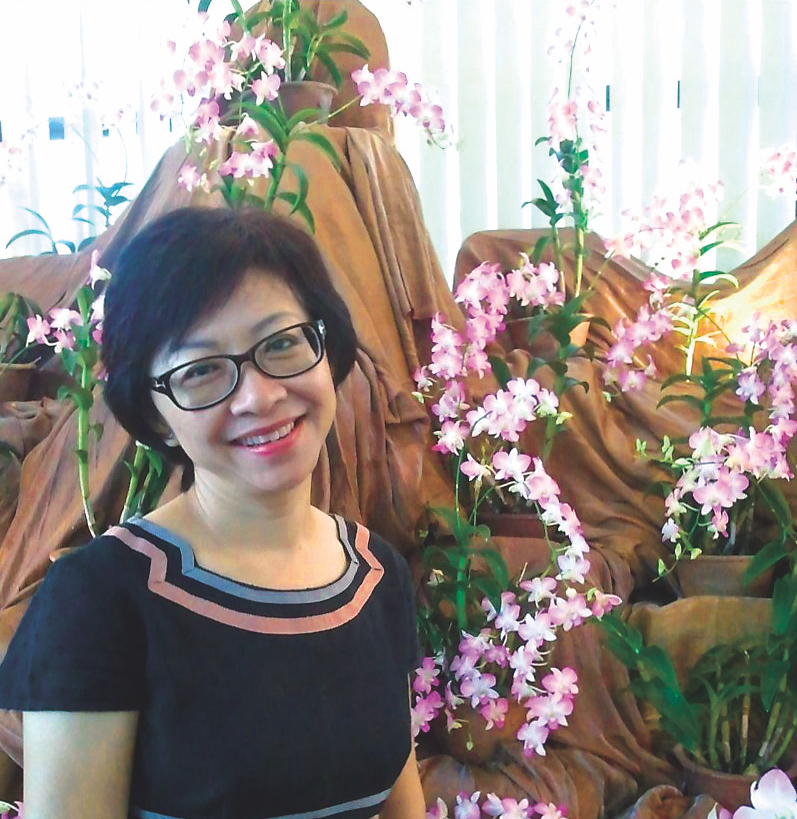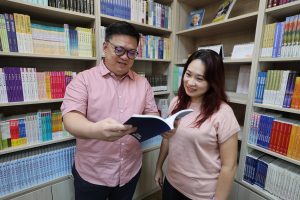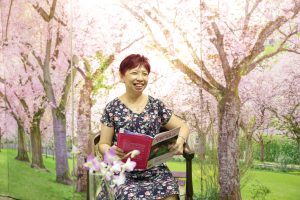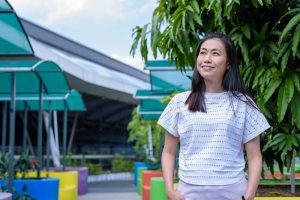
Constance Leong Chui Ying
Women Division Leader
Joined SSA in 1982
In 1978, my sister encountered marital problem when her son was only one year old. Her colleague introduced her to Nichiren Buddhism and she started chanting, hoping to save her marriage. One year later, my sister received the Gohonzon (the object of devotion in Nichiren Buddhism) in 1979. Although my sister tried to encourage me to start practising faith and even handed me some SSA organ publications to read, I remember telling her coldly that I preferred to be a free thinker.
I joined the nursing profession in 1977 after completing my GCE “O” levels. I loved my job although it involved irregular working hours and hectic nature of work. I was in a steady relationship with my boyfriend, who is now my husband. My smooth-sailing days took a sudden turn in August 1981 when I began suffering from health problems. I became mentally and physically drained and even started to hear voices. I became very frightened and disturbed and was not able to concentrate in my work.
One night, I tried to force myself to go for my night duty even though I was not well. My senior nurse commented that I looked pale and sick. The next morning, I went home, my heart was yelling for help. At that moment, the phrase Nam-myoho-renge-kyo simply appeared in my mind and since then, I began chanting daimoku. This was how I began my practice.
Thereafter, I began getting up earlier in the morning to chant daimoku before leaving for work. Initially, it was a struggle to even chant. I felt so breathless but as I continued to chant, I began to feel better. I remember setting the challenge that if I mastered the recitation of Gongyo within 3 months and fully recovered from my sickness, I would receive the Gohonzon. I regained my health without me even realising it. That was my first actual proof of faith.
I started participating in more SSA activities. Having benefitted so much from this Buddhist practice myself, I tried introducing it to people I met, although I did not know much about Buddhism yet. I shared my benefits of overcoming my sickness with my then boyfriend, Lawrence, (now my husband) but he was quite sceptical and the expression on his face told me: “Don’t get me involved.”
One year later in December 1982, I received my Gohonzon with my parents’ blessing. I got married in 1984. It was in the Women Division (WD) that I learnt that we should become the sun of the family – to be always gracious, gentle and wise, especially when it was such a challenge maintaining the balance of devoting time for family, work and kosen-rufu activities. I brought my two children with me for activities, and my husband, being ever supportive, would pick us up after the meetings.
The Greatest Trial in My Life
I continued to enjoy a life of good health, blessed with a happy and financially-stable family until the greatest trial in my life occurred on the night of 9th November 2002. My 15-year-old son suddenly collapsed on the sofa while watching TV with his father. My husband and I performed CPR (cardiopulmonary resuscitation) on him for more than half an hour. Despite all efforts by the paramedics and doctors, he passed away.
Though grief-stricken and devastated, my husband agreed to have the SSA funeral rites for our son. I worried for my husband, daughter, parents and parents in-laws. How would they cope? Despite the fear, shock and unbearable pain of loss, I managed to remain strong and composed. Looking back, I attribute that composure to my 22 years of practice. The sincere prayers and wholehearted encouragement we received from fellow SSA members during the wake deeply touched my in-laws and relatives. They were very comforted by the great support rendered by my comrades-in-faith. It was also during this period of bereavement that my husband began to chant.
I was grateful that my husband joined me in overcoming the grief based on faith in Nichiren Buddhism. Honestly, I was initially tormented by the fact that despite being a nurse, I could not save my son. It was made worse by the criticisms I heard from some people who did not understand the situation. Each time I chanted before the Gohonzon, I would cry my heart out. During my darkest moments, many senior leaders allayed my doubts. Though they could not alleviate the pain I was going through, their warm encouragement kept me going as I tried to grasp the profound meaning behind what had happened.
I came across the encouragement that SGI President Daisaku Ikeda gave to Sonia Gandhi, the wife of late Indian Prime Minister Rajiv Gandhi, who was assassinated. President Ikeda told her: “If you are sad, your husband will grieve, too. If you stand up with a smile, he will be happy. Please keep advancing. Do not look back. Not looking back is extremely difficult and it may even be impossible… Victory lies in moving forward, so do glory and happiness. The deeper your suffering, the brighter and more luminous the happiness that will greet you on the dawn.”
These words woke me up; faith in the Gohonzon is about bringing forth hope, bringing boundless inner strength and wisdom that already exist within us. And faith in Nichiren Buddhism can enable us to draw forth this strength from within our lives. I told myself, “I need to be strong. I cannot let grief defeat me. I must triumph for my son’s sake.” Chanting for strong life force, courage and wisdom, I resumed momentum of my practice and strove to fulfil my leadership responsibility and went for activities and home visits.
Slowly, I began to understand the profound meaning of losing my son. As Second Soka Gakkai President Josei Toda said, “Children are emissaries from the infinite past. They were born in this world to enable their parents and others around them to attain Buddhahood.” It was his mission to arouse his father’s faith in Nichiren Buddhism. As Lawrence’s faith deepened, his perception of our son’s passing also began to change. My son usually went out with his friends on Saturday nights. At first, we did not understand why he was at home that fateful evening. We realised thankfully that our boy had wanted to stay at home with us for the last time.
My son, in his unique way, had accomplished his mission in this lifetime. His passing had enabled my family to develop a deeper understanding of life and death – understanding that life is eternal and death is not an end but a new departure of a new life. No one can escape death. Therefore, it is not whether our lives are long or short, but whether, while alive, we form a connection with Nichiren Buddhism to tap our innermost potential, and through our faith, create value by contributing to the well being of the community.
We cannot change the fact that our son has passed on. But I have learned that I could create value through this painful experience. Instead of remembering it as a painful ordeal, my son’s passing has become my special mission. Over the years, I had visited numerous fellow members going through similar experiences to offer comfort and encouragement as I could truly empathise with them.
I have also been contributing actively in the SSA medical and the volunteer groups, to contribute my part in the senior citizen activities and community service projects.
Our years of steadfast practice have indeed changed our lives for the better. My daughter, on seeing how her parents based their lives on the Mystic Law and striving tirelessly for kosen-rufu (peace and happiness of the people), is now actively participating in SSA activities and has also taken up a leadership role.
We resolve to continue to strive hard for kosen-rufu as we are able to understand the meaning of transforming karma into mission. It is only through this process are we able to establish an indestructible and happy existence. We will continue to spread the circle of happiness to others. It is only by always basing ourselves on faith and showing actual proof and emerging as a victor in life that we can truly live a fulfilled, value-creative life.
(Adapted from the Soka Women’s testimony book A Friend in the Orchid Room)


